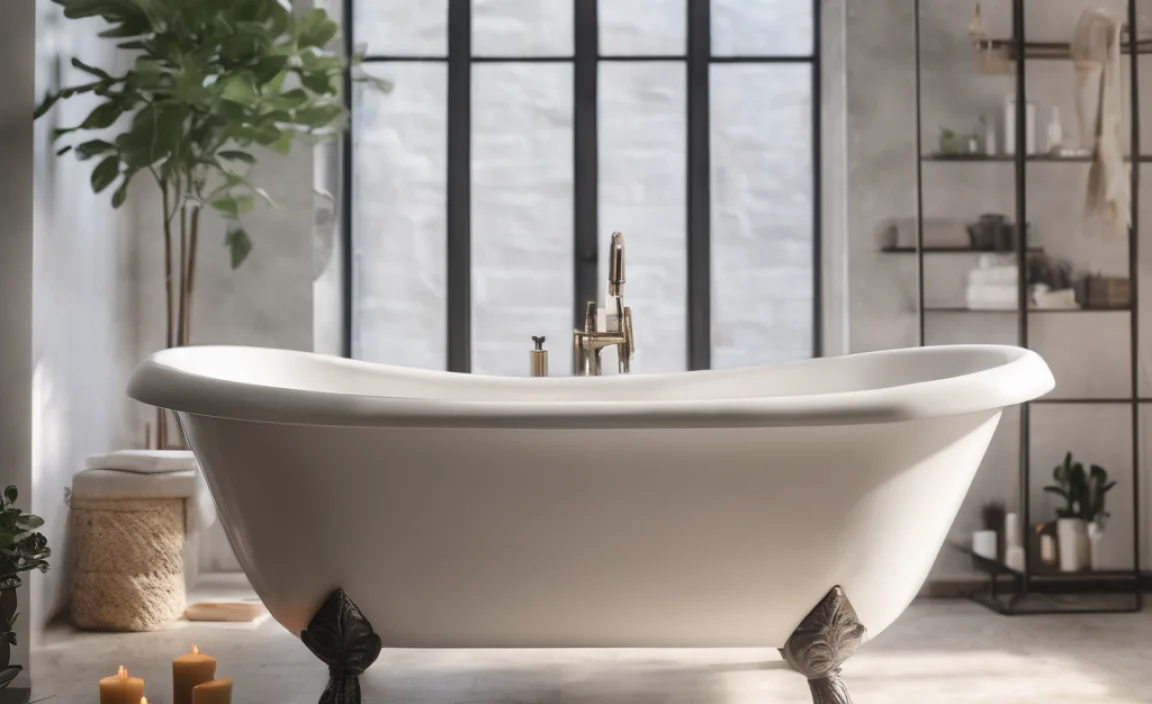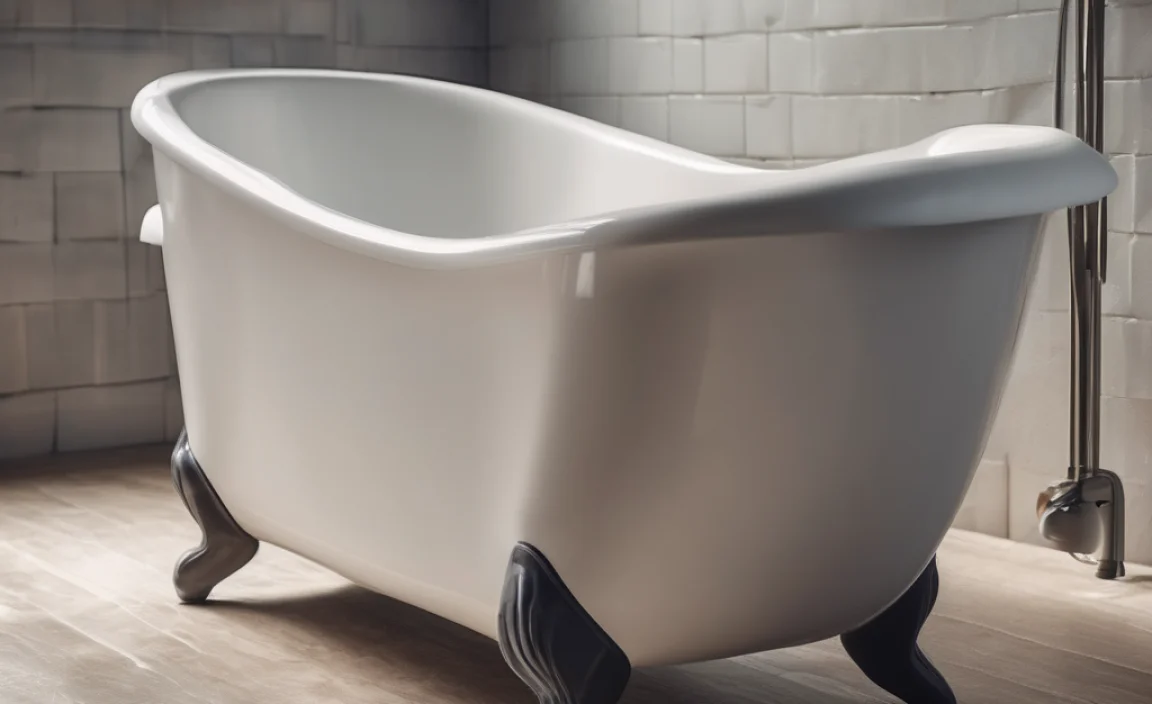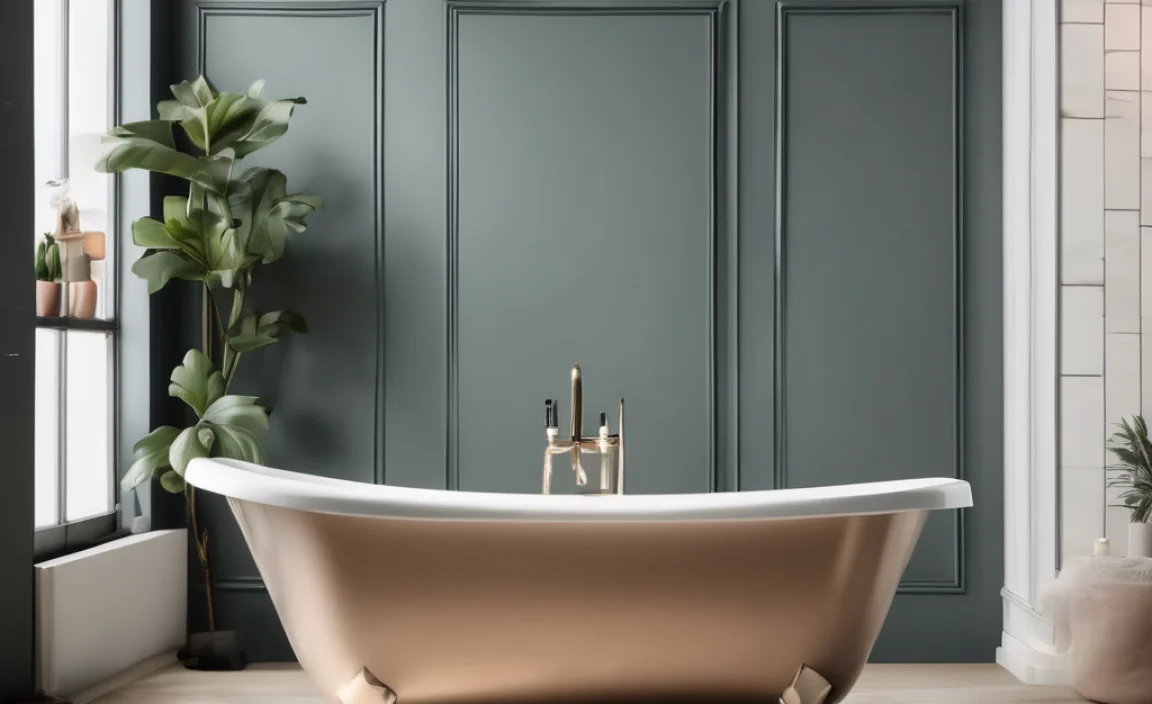A slipper bathtub is a freestanding tub with one or both ends raised for comfortable lounging. The elevated end provides excellent back support, making your bath feel more like a luxurious spa experience. Slipper tubs come in single or double-ended designs and various materials, adding elegance and comfort to any bathroom.
Ever dream of sinking into a hot bath and feeling all your stress melt away? But instead, you end up awkwardly propped against the tub’s edge, searching for that perfect position? A slipper bathtub might be your answer! These tubs aren’t just beautiful; they’re designed for serious relaxation.
In this guide, we’ll explore everything about slipper bathtubs. We’ll cover the different types, materials, and styles. Plus, we’ll help you decide if a slipper tub is the right choice for your bathroom. Ready to turn your bathroom into a relaxing retreat? Let’s dive in!
What Exactly is a Slipper Bathtub?

A slipper bathtub is a freestanding tub known for its unique shape and comfortable design. Unlike standard tubs with straight sides, a slipper tub features one or both ends raised, resembling a slipper. This design provides excellent back support, allowing you to recline comfortably and enjoy a longer, more relaxing bath.
Key Features of a Slipper Bathtub
- Raised Ends: One or both ends are elevated for back and neck support.
- Freestanding Design: Sits independently without needing to be built into walls.
- Elegant Aesthetics: Adds a touch of vintage or modern elegance to any bathroom.
- Deep Soaking: Typically deeper than standard tubs, allowing for full immersion.
Types of Slipper Bathtubs

Slipper bathtubs come in two main styles: single slipper and double slipper. Each type offers a unique bathing experience.
Single Slipper Bathtubs
A single slipper bathtub has one raised end for reclining. This design is perfect for those who want focused back support and a clear view of the bathroom.
- Design: One end is raised and sloped for comfortable back support.
- Benefits: Ideal for solo relaxation and offers a clear view.
- Placement: Works well against a wall or as a focal point in the bathroom.
Double Slipper Bathtubs
A double slipper bathtub has both ends raised, providing comfort for either end of the tub. This design is great for sharing a bath or simply having the flexibility to recline at either end.
- Design: Both ends are raised, allowing you to recline at either end.
- Benefits: Perfect for couples or those who want flexibility.
- Placement: Best suited for larger bathrooms where it can be a central feature.
Materials Used in Slipper Bathtubs

Slipper bathtubs are made from various materials, each offering different benefits in terms of durability, heat retention, and aesthetics.
Acrylic
Acrylic is a popular choice for slipper bathtubs due to its lightweight nature and ability to retain heat.
- Pros: Lightweight, good heat retention, affordable, easy to repair.
- Cons: Can scratch more easily than other materials.
- Maintenance: Clean with non-abrasive cleaners.
Cast Iron
Cast iron tubs are known for their exceptional durability and heat retention. They offer a classic, sturdy feel.
- Pros: Excellent heat retention, very durable, classic look.
- Cons: Very heavy, can be expensive.
- Maintenance: Requires regular cleaning to prevent rust.
Copper
Copper bathtubs offer a unique, luxurious look and excellent heat conductivity.
- Pros: Excellent heat conductivity, naturally antibacterial, beautiful aesthetic.
- Cons: Expensive, requires special cleaning products.
- Maintenance: Clean with copper-specific cleaners to maintain shine.
Stone Resin
Stone resin tubs are made from a blend of natural stone and resin, offering a modern, sleek look.
- Pros: Durable, good heat retention, non-porous, modern look.
- Cons: Can be heavy, more expensive than acrylic.
- Maintenance: Clean with mild, non-abrasive cleaners.
Steel
Steel bathtubs are known for their durability and affordability. While they don’t retain heat as well as cast iron or copper, they are a practical option for many homeowners.
- Pros: Durable, affordable, lighter than cast iron.
- Cons: Poor heat retention, prone to chipping.
- Maintenance: Regular cleaning to prevent rust and damage to the enamel coating.
Here’s a quick comparison of the materials:
| Material | Pros | Cons | Maintenance |
|---|---|---|---|
| Acrylic | Lightweight, good heat retention, affordable | Can scratch easily | Non-abrasive cleaners |
| Cast Iron | Excellent heat retention, very durable | Very heavy, expensive | Regular cleaning to prevent rust |
| Copper | Excellent heat conductivity, antibacterial, beautiful | Expensive, requires special cleaners | Copper-specific cleaners |
| Stone Resin | Durable, good heat retention, non-porous | Can be heavy, more expensive than acrylic | Mild, non-abrasive cleaners |
| Steel | Durable, affordable, lighter than cast iron | Poor heat retention, prone to chipping | Regular cleaning to prevent rust |
Styles of Slipper Bathtubs
Slipper bathtubs come in various styles to match different bathroom decors. Here are some popular options:
Vintage/Clawfoot
Vintage slipper tubs often feature clawfoot legs, adding a classic, antique touch to your bathroom.
- Design: Clawfoot legs, traditional shape.
- Features: Ornate details, classic hardware.
- Best For: Traditional or Victorian-style bathrooms.
Modern
Modern slipper tubs have clean lines and minimalist designs, perfect for contemporary bathrooms.
- Design: Sleek, minimalist shape.
- Features: Simple lines, integrated overflow drains.
- Best For: Modern or minimalist bathrooms.
Farmhouse
Farmhouse slipper tubs combine rustic charm with modern comfort, often featuring a simple, elegant design.
- Design: Simple, elegant shape.
- Features: Clean lines, vintage-inspired faucets.
- Best For: Farmhouse or transitional-style bathrooms.
Factors to Consider When Choosing a Slipper Bathtub
Choosing the right slipper bathtub involves considering several factors to ensure it fits your needs and bathroom space.
Bathroom Size and Layout
Measure your bathroom to ensure the slipper tub fits comfortably without overcrowding the space. Consider the placement of other fixtures like the toilet and sink.
- Measure: Accurately measure the available space.
- Layout: Plan the tub’s placement in relation to other fixtures.
- Clearance: Ensure enough space for movement around the tub.
Budget
Slipper bathtubs range in price depending on the material and style. Set a budget before you start shopping to narrow down your options.
- Material Costs: Copper and cast iron are generally more expensive than acrylic.
- Installation Costs: Factor in plumbing and installation fees.
- Long-Term Value: Consider durability and maintenance costs.
Plumbing Requirements
Slipper bathtubs require specific plumbing considerations, especially for freestanding models. Ensure your plumbing is compatible or can be adapted.
- Faucet Placement: Decide whether you want deck-mounted, wall-mounted, or freestanding faucets.
- Drainage: Ensure proper drainage and overflow systems.
- Professional Installation: Consider hiring a plumber for installation to avoid issues.
Personal Preferences
Think about your personal style and how you plan to use the tub. Do you prefer a deep soak, or do you want a tub that complements your bathroom’s aesthetic?
- Bathing Habits: Consider how often and how long you typically bathe.
- Style Preferences: Choose a style that matches your bathroom decor.
- Comfort: Opt for a design that provides the comfort and support you need.
Installation Tips for Slipper Bathtubs
Installing a slipper bathtub can be a DIY project or require professional help. Here are some tips to ensure a smooth installation.
Prepare the Space
Ensure the bathroom floor is level and strong enough to support the tub’s weight, especially for cast iron or stone resin models.
- Level Floor: Correct any unevenness in the flooring.
- Reinforce Structure: Add extra support if needed.
- Clean Area: Remove debris and ensure a clean workspace.
Gather the Necessary Tools
Collect all the tools you’ll need for the installation, including a level, plumber’s tape, wrenches, and safety glasses.
- Plumbing Tools: Wrenches, pipe cutters, plumber’s tape.
- Safety Gear: Safety glasses, gloves.
- Measuring Tools: Level, measuring tape.
Follow the Manufacturer’s Instructions
Carefully read and follow the manufacturer’s instructions for installing your specific slipper bathtub model.
- Read Manual: Understand all steps and requirements.
- Step-by-Step: Follow each step in the correct order.
- Checklist: Use a checklist to ensure you don’t miss any steps.
Connect the Plumbing
Properly connect the water supply and drain lines, ensuring all connections are tight and leak-free.
- Water Supply: Connect hot and cold water lines.
- Drainage: Install the drain and overflow system.
- Leak Test: Check for leaks after connecting all plumbing.
Secure the Tub
Secure the tub to the floor or its legs to prevent movement. Use shims to ensure it’s level and stable.
- Leveling: Use shims to adjust the tub’s level.
- Attachment: Secure the tub to the floor or legs.
- Stability: Ensure the tub is stable and doesn’t rock.
Here’s a table summarizing the installation steps:
| Step | Description | Tools Needed |
|---|---|---|
| Prepare the Space | Ensure the floor is level and strong enough to support the tub. | Level, measuring tape |
| Gather Tools | Collect all necessary tools for the installation. | Plumbing tools, safety gear, measuring tools |
| Follow Instructions | Carefully read and follow the manufacturer’s instructions. | Manual, checklist |
| Connect Plumbing | Properly connect the water supply and drain lines. | Wrenches, pipe cutters, plumber’s tape |
| Secure the Tub | Secure the tub to the floor or its legs. | Shims, screws |
Maintaining Your Slipper Bathtub
Proper maintenance will keep your slipper bathtub looking beautiful and functioning well for years. Here are some tips:
Regular Cleaning
Clean your slipper bathtub regularly with mild soap and water. Avoid abrasive cleaners that can scratch the surface.
- Daily Cleaning: Rinse the tub after each use.
- Weekly Cleaning: Use mild soap and a soft cloth to clean the tub.
- Avoid Abrasives: Do not use harsh chemicals or abrasive scrubbers.
Preventing Stains and Scratches
Take steps to prevent stains and scratches by using a soft cloth and avoiding harsh chemicals.
- Soft Cloth: Use a soft cloth for cleaning.
- Avoid Chemicals: Avoid harsh chemicals that can damage the finish.
- Protect Surface: Use a bath mat to protect the tub from scratches.
Checking for Leaks
Regularly check the plumbing connections for leaks and address any issues promptly to prevent water damage.
- Inspect Connections: Check water supply and drain connections.
- Look for Moisture: Look for signs of moisture or water damage around the tub.
- Tighten Fittings: Tighten any loose fittings to prevent leaks.
Maintaining the Finish
Depending on the material of your tub, use appropriate products to maintain the finish. For example, use copper-specific cleaners for copper tubs.
- Acrylic: Use acrylic-specific cleaners.
- Cast Iron: Use enamel-safe cleaners.
- Copper: Use copper-specific cleaners.
Pros and Cons of Slipper Bathtubs
Before making a decision, consider the pros and cons of slipper bathtubs to determine if they are the right choice for you.
Pros
- Comfort: Raised ends provide excellent back support.
- Aesthetics: Adds a touch of elegance to any bathroom.
- Deep Soaking: Allows for full immersion and relaxation.
- Variety of Styles: Available in various styles to match different decors.
Cons
- Cost: Can be more expensive than standard tubs.
- Space: Requires more space than built-in tubs.
- Weight: Some materials, like cast iron, can be very heavy.
- Installation: May require professional plumbing.
Slipper Bathtub FAQs
1. What is the main benefit of a slipper bathtub?
The main benefit is the enhanced comfort due to the raised end, which provides excellent back and neck support for a more relaxing bathing experience.
2. Are slipper bathtubs suitable for small bathrooms?
Slipper bathtubs generally require more space than standard tubs. However, smaller models are available. Measure your bathroom carefully to ensure a good fit.
3. How do I clean a slipper bathtub?
Clean your slipper bathtub with mild soap and water. Avoid abrasive cleaners that can scratch the surface. Use cleaners specific to the tub’s material for best results.
4. Can I install a slipper bathtub myself?
While some homeowners can install a slipper bathtub themselves, it’s often best to hire a professional plumber to ensure proper plumbing connections and avoid potential issues.
5. What is the difference between a single slipper and a double slipper bathtub?
A single slipper bathtub has one raised end for reclining, while a double slipper bathtub has both ends raised, allowing you to recline at either end.
6. What faucet types work best with slipper tubs?
Deck-mounted, wall-mounted, or freestanding faucets work well with slipper tubs. The choice depends on your bathroom’s layout and your personal style preferences.
7. Are slipper bathtubs more expensive than regular bathtubs?
Yes, slipper bathtubs are generally more expensive than standard tubs due to their unique design, material options, and installation requirements.
Conclusion
A slipper bathtub can transform your bathroom into a luxurious retreat. With its comfortable design and elegant aesthetics, it’s a great choice for anyone looking to enhance their bathing experience. By understanding the different types, materials, styles, and installation considerations, you can choose the perfect slipper bathtub for your home. So go ahead, take the plunge, and create the bathroom of your dreams!



